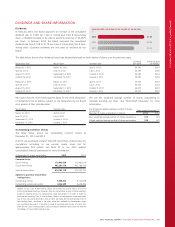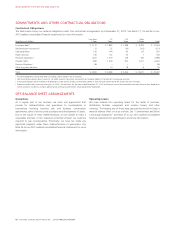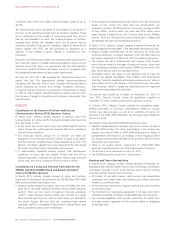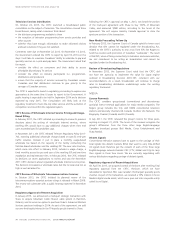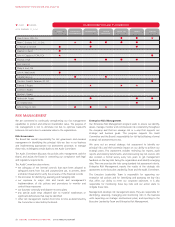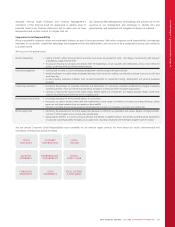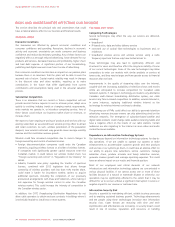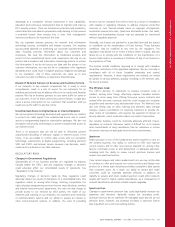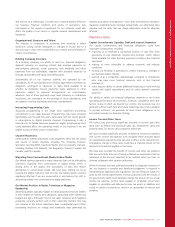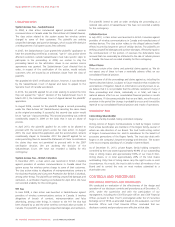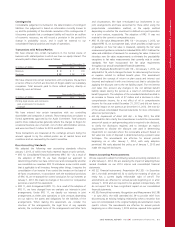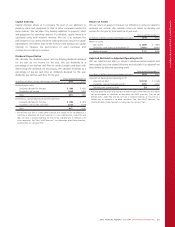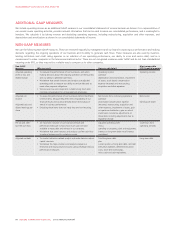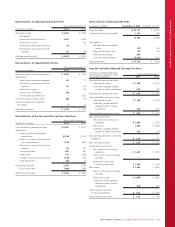Rogers 2013 Annual Report Download - page 79
Download and view the complete annual report
Please find page 79 of the 2013 Rogers annual report below. You can navigate through the pages in the report by either clicking on the pages listed below, or by using the keyword search tool below to find specific information within the annual report.
MANAGEMENT’S DISCUSSION AND ANALYSIS
advantage to a competitor. Annual investments in new capabilities,
education and continuous improvement help to maintain and improve
RCI’s security posture. These are focused on protection and prevention,
robust detection and advance preparation and planning to help prevent
a potential breach from turning into a crisis. Risk management
resources continue to be focused in this area.
We use standard industry practices for network and information
technology security, survivability and disaster recovery. Our ongoing
success partly depends on protecting our corporate business-sensitive
data, including personal information about our customers and
employees. We treat this information as intellectual property and
protect it from unauthorized access and compromise. We rely on our
policies and procedures and information technology systems to protect
this information. If we do not secure our data and the privacy of our
customer information, we may not be in compliance with regulatory
standards and it could result in negative publicity, litigation and damage
to our reputation. Any of these outcomes can cause us to lose
customers or public confidence, or experience financial losses.
Impact of Network Failures on Revenue and Customer Service
If our networks or key network components fail, it could, in some
circumstances, result in a loss of service for our customers for an
indefinite period and have an adverse effect on our results and financial
position. We rely on business partners to carry some traffic for some of
our customers. If one of these carriers has a service failure, it might also
cause a service interruption for our customers that would last until we
could reroute the traffic to another carrier.
Unauthorized Access to Digital Boxes or Internet Modems
We use encryption technology developed and supported by our vendors
to protect our cable signals from unauthorized access and to control
access to programming based on subscription packages. We also use
encryption and security technologies to prevent unauthorized access to
our Internet service.
There is no assurance that we will be able to effectively prevent
unauthorized decoding of television signals or Internet access in the
future. If we are unable to control cable access with our encryption
technology, subscriptions to digital programming, including premium
VOD and SVOD, and Internet service revenues may decrease, which
could result in a decline in our cable revenues.
REGULATORY RISKS
Changes in Government Regulations
Substantially all of our business activities are regulated by Industry
Canada and/or the CRTC, and any regulatory changes or decisions
could adversely affect our consolidated results of operations. See
“Regulation in Our Industry”.
Regulatory changes or decisions made by these regulators could
adversely impact our results of operations on a consolidated basis. This
regulation relates to, among other things, licencing, competition, the
cable television programming services that we must distribute, wireless
and wireline interconnection agreements, the rates we may charge to
provide access to our network by third parties, the resale of our
networks and roaming on our networks, our operation and ownership
of communications systems and our ability to acquire an interest in
other communications systems. In addition, the costs of providing
services may be increased from time-to-time as a result of compliance
with industry or legislative initiatives to address consumer protection
concerns or such Internet-related issues as copyright infringement,
unsolicited commercial e-mail, cybercrime and lawful access. Our cable,
wireless and broadcasting licences may not generally be transferred
without regulatory approval.
Generally, our licences are granted for a specified term and are subject
to conditions on the maintenance of these licences. These licencing
conditions may be modified at any time by the regulators. The
regulators may decide not to renew a licence when it expires, and any
failure by us to comply with the conditions on the maintenance of a
licence could result in a revocation or forfeiture of any of our licences or
the imposition of fines.
The licences include conditions requiring us to comply with Canadian
ownership restrictions of the applicable legislation. We are currently in
compliance with all of these Canadian ownership and control
requirements. However, if these requirements are violated, we would
be subject to various penalties, possibly including, in the extreme case,
the loss of a licence.
The Wireless Code
The CRTC’s decision to implement its wireless consumer code of
conduct, among other things, effectively requires Canadian wireless
carriers to move away from offering three-year service contracts and
instead offer two-year contracts, and this could change our customer
acquisition and retention costs and subscriber churn. The Wireless Code
also sets billing caps on data roaming and domestic data overage
charges, creates a prohibition on requiring customers to provide 30-
days’ notice of cancellation, and requires the payment of interest on
security deposits, which could also reduce our results of operations.
Our wireless business could be materially adversely affected if laws,
regulation or customer behaviour makes it difficult for us to impose
term commitments or early cancellation fees on customers or receive
the service revenues we anticipate from the term commitments.
Spectrum
Radio spectrum is one of the fundamental assets required to carry on
the wireless business. Our ability to continue to offer and improve
current services and to offer new services depends on, among other
factors, continued access to and deployment of adequate spectrum,
including both the ability to renew current spectrum licenses and
acquire new spectrum licenses.
If we cannot acquire and retain needed spectrum, we may not be able
to continue to offer and improve our current services and deploy new
services on a timely basis including providing competitive data speeds
that customers want. As a result, our ability to attract and retain
customers could be materially adversely affected. In addition, an
inability to acquire and retain needed spectrum could affect network
quality and result in higher capital expenditures, as a consequence of
network densification and other related network upgrades.
Spectrum Fees
Changes to government spectrum fees could significantly increase our
payments and therefore materially reduce our operating profit.
Spectrum licences are an indefinite life intangible asset and we do not
amortize them, however, any potential increases in spectrum licence
fees may affect our current accounting policies.
2013 ANNUAL REPORT ROGERS COMMUNICATIONS INC. 75


